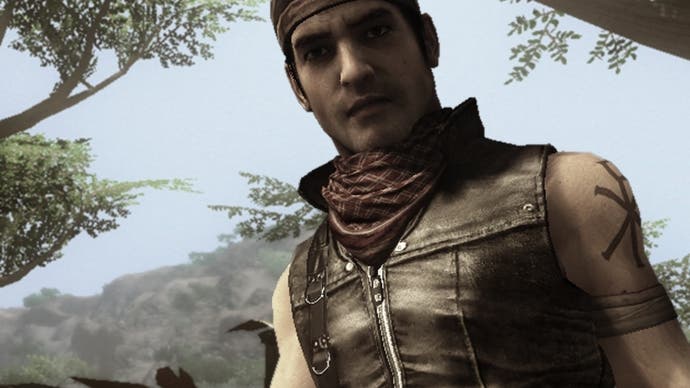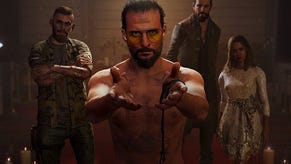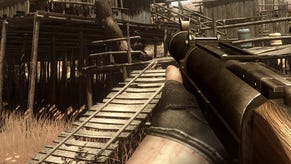Far Cry 2's single-minded vision deserves to be remembered
This is Africa.
Sequels tend to be like Russian dolls: they get bigger and bigger until the little doll that started it all is buried deep. Or to use a food analogy, like a Five Guys milkshake - taller and sweeter with more whipped cream on top every time. Who's going to say no to the extra sugar? Not me. And so the cycle continues. More cream is squeezed from the nozzle of a dispenser, a fatter doll is slotted into place and since we never look back, we take for granted that what we're enjoying is the way it's always been.
You've forgotten about Far Cry 2 no doubt. That's okay. It was Ubisoft's first stab at the series. We've had the successively sweet, sugar-laden adventures since, but the essential Far Cry experience as you know it starts somewhere in Africa. "We could have done so many locations," reveals Pierre Rivest, lead game designer on Far Cry 2 and a veteran of the company from 1997 until 2009. "We explored so many ideas, and some of the stuff we came up with hasn't even been done yet in 2018."
Oh?
"Yes, but I can't say more," he says with a smile. "Ubisoft might be working on them."
Four of five locations were proposed and Africa was eventually chosen. "We had things we could leverage, like malaria and black market diamonds and we could put the player in the jungle, the desert, varied areas," Rivest remembers. Africa also gave the team space to work with. They set about repurposing the original Crytek engine to facilitate a giant sandbox, naming the engine Dunia in the process. Far Cry 2 would be marketed on the sheer size of the world - 50 square kilometres of fully explorable terrain.
The results are beautiful, even today, though don't squint at the individual grains of sand too closely. And on the Xbox One X there's a strange artefact that makes shadows in the game look as if they're covered by a patchwork quilt. But put it this way: if the Microsoft boffins decide to bring the game up to speed for 4K TVs they wouldn't need to do anything to the art direction. When you wake up in the morning and the sun is at half-mast spilling onto terracotta-coloured sand, you remember that this series is really, at its essence, about bringing spectacular locations to life.
You're in Africa to bring down an arms dealer known by the name The Jackal who is fuelling both sides of a civil war. The APR and UFLL have headquarters on either side of a long narrow road studded with sentry posts and sandbags, like something out of a terrible scene from a Louis Theroux documentary. It's all so real somehow. On the ground, the details we've come to expect are present. You commandeer cars. You save your game when you sleep at hideaways. You scout enemy outposts with a monocular (a less useful version of the binoculars found in later games). There are even a couple of stray hang-gliders lying around like remnants from a half-remembered dream, waiting to be snapped up for a jaunt in the highlands of Kyrat. Far Cry 2 is the blueprint; that first babushka doll. And yet it feels stripped back, positively lean. There's no mini map blinking cheerily with side quests and whaddaya know, there are no radio towers either. The story - what story there is - is spartan. Mostly, the muzzle of your rifle does the talking.
In the uncompromising African terrain luxuries are rare. Fast travel points are spaced apart and driving in the open often leads to gunfire on the side of a dirt path. Sometimes your weapon stops reloading in the middle of the gunfight because of dirt and grime. Heck, before you've even got a gun you're infected with malaria.
"We did want to make the player struggle," Rivest admits, "but at the time, we didn't have a point of comparison. We couldn't say, 'let's make it like this game' because this was kinda like a first stab at it. A lot of players don't like to struggle these days, but this wasn't even a consideration for us back then, and maybe something like Dark Souls is making people realise that it's actually kinda fun to struggle."
While later Far Cry games have gently eased you into the fold, Far Cry 2 was designed to leave you to it. "The idea was that we didn't want to tell players how to play," Rivest recalls. "We wanted players to leverage the systems in place and create their own experience." After a short tutorial the shackles are, sure enough, released. Five minutes in the savannah with a bunch of grenades and you can set the world alight like The Joker.
Then there are the AI buddies. The buddies are a context-sensitive second-chance mechanic woven into the fabric of the game who, if you remember, give you alternative routes through story missions. But they can get hurt and die too, which cuts them out of the story entirely. Though I'm yet to play it, I'm interested to read that Far Cry 5 has introduced a similar mechanic in the form of Specialists and Guns for Hire.

Back in Africa, drive around with abandon and you'll find enemy outposts who try to cut you down to size. All round, there's a conspicuous absence of cutscenes or scripted sequences or any convention you see today in a AAA shooter of this ilk.
But this free form nature means the game occasionally falters and I can't go any further without discussing the outposts. The outposts! All around the world you'll find guards armed to the teeth, waiting at intersections, often behind the impersonal steel of a sentry gun. What's supposed to be a challenge turns the game into a slog, because no matter how many times you wipe out one set of guards, new men return on your next visit. Why bother fighting them at all, I wonder.
"The outposts are one of the things we wished we had done differently," Rivest admits. At one point in the project the team had opted for "full on persistency"; in other words, if you blew up everything in your vicinity and came back ten in-game days later you'd still be faced with the smouldering remains of your handiwork. "And we realised that you could empty the whole game world and have nothing else to do," Pierre says, "and that didn't work too well, so we turned the knob, but we turned it too far the other way."
Using a method called sectorisation, Ubisoft would reload assets the minute they were out of sight and return them to their original state. "So if you went and did your mission and were far enough away that the outpost was not visible, it would reload when you came back."
Rivest continues: "At one point we were drawn to the idea that all the outposts would slowly be rebuilt; so you would destroy one, and once you returned after X amount of in-game time you'd go back to a half-repaired outpost. Unfortunately for different reasons that kinda slipped; so we went with pure technical solution of sectorisation, or resetting.

In hindsight, I can understand why later Far Cry games have taken a more cosseting approach, doling out new areas of the map in digestible chunks, and throwing you carefully curated slices of story. And yet as a new Far Cry is released into the wild it's nice to see Ubisoft going back to some of the ideas that Pierre Rivest and his team brought to life: the idea that you don't need a mini map squawking at you every 30 seconds, and that it's okay to get lost in the world with no radio towers in sight (as an aside, who else loves the Far Cry 2 map - a physical piece of paper you whip out before your eyes with a flourish?).
All of which leads me to the inevitable: with its uncompromising vision and its spartan execution Far Cry 2 is possibly the best game in the series. Only, in my humble opinion, it isn't. After all these years I have to be honest and say that it feels a bit clunky and that there are some sizable balancing issues - and call me a philistine but I like a sprinkling of sugar, meaning I enjoy Far Cry 3's easy thrills more.
Yet there's a lesson here all the same. Less really can be more and Far Cry 2 leaves a sizable impression, especially compared to its modern peers. Were a new game made in its image it'd be something very special indeed. That's the thing about iteration: for all the gloss you add you're not exactly sharpening the focus. Ten years on, Far Cry 2's vision feels more important than ever.
Thanks to Pierre Rivest for taking part in this interview. Pierre is currently working at Reflector Entertainment under the stewardship of Alex Anancio, who himself was art director on Far Cry 2.










